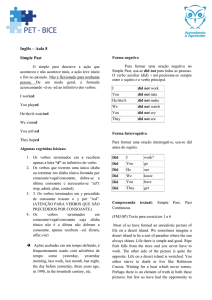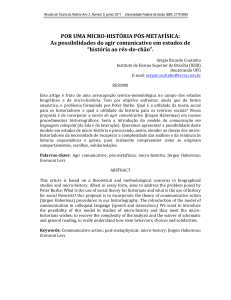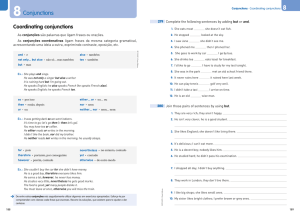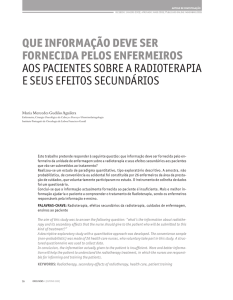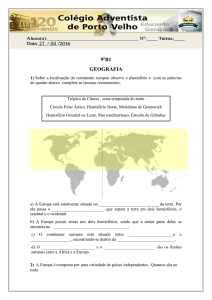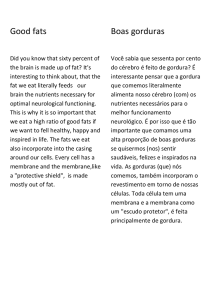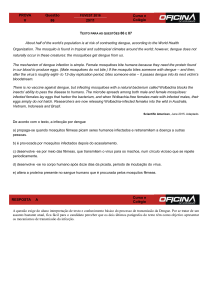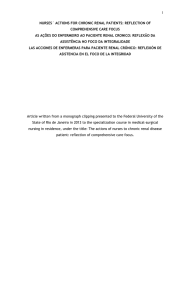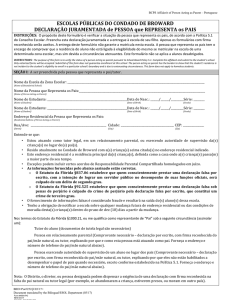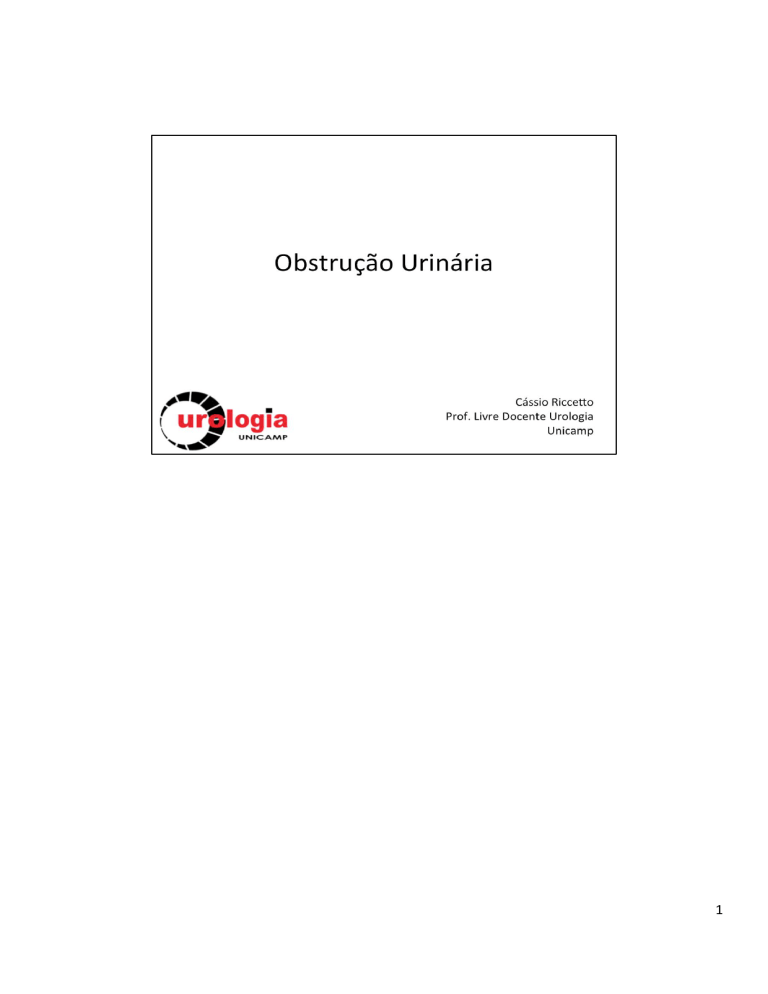
1 Visão geral do trato urinário e pontos de obstrução mais frequentes. 2 Uretra masculina e suas partes. 3 A brief discussion of the determinants of glomerular filtra@on is in order to understand the interrela@onships between changes in renal hemodynamics and altera@ons in the glomerular filtra@on rate (GFR) during and aHer obstruc@on. Factors influencing GFR are expressed in the following equa@on: GFR=Kf(PGC −PT −πGC) Kf is a glomerular ultrafiltra@on coefficient related to the surface area and permeability of the capillary membrane. PGC is the glomerular capillary pressure, which is influenced by renal plasma flow and the resistances of the afferent and efferent arterioles. The hydraulic pressure driving fluid into Bowman space is resisted by the hydraulic pressure of fluid in the tubule (PT), and also the increasing onco@c pressure (π) of the proteins remaining at higher concentra@ons in the late glomerular capillary and efferent arteriolar blood. Although filtered fluid is not completely free of small proteins, for prac@cal purposes, its onco@c pressure is negligible. The net pressure determining glomerular filtra@on is referred to as the ultrafiltra@on pressure (PUF) and is derived from (PGC − PT − πGC). PGC is also influenced by renal plasma flow (RPF). RPF depends upon the renal perfusion pressure and intrarenal resistance to flow, the laXer primarily mediated by the resistances in the afferent and efferent arterioles. The aforemen@oned rela@onships are depicted in the following equa@on: RPF = aor@c pressure − renal venous pressure renal vascular resistance Thus constric@on of the afferent or efferent arteriole or both would reduce RPF. Constric@on of the afferent arteriole results in a decrease of PGC and GFR, whereas an increase in efferent arteriolar resistance increases PGC. Whole kidney GFR depends upon factors regula@ng perfusion of each glomerulus and also upon the percentage of glomeruli actually filtering. For each glomerulus, the single-­‐nephron glomerular filtra@on rate (SNGFR) is determined by the previously men@oned GFR equa@on. Obstruc@on can transiently or permanently alter GFR and some or all of the determinants of GFR. Campbell’s Urology 5th Edi@on 4 Triphasic rela@onship between ipsilateral renal blood flow and leH ureteral pressure during 18 hours of leH-­‐sided occlusion. The three phases are designated by roman numerals and separated by ver@cal dashed lines. In phase I, renal blood flow and ureteral pressure rise together. In phase II, the leH renal blood flow begins to decline and ureteral pressure remains elevated and, in fact, con@nues to rise. In phase III, the leH renal blood flow and ureteral pressure decline together. (From Moody TE, Vaughn ED Jr, Gillenwater JY. Rela@onship between renal blood flow and ureteral pressure during 18 hours of total unilateral ureteral occlusion. Implica@ons for changing sites of increased renal resistance. Invest Urol 1975;13:246–51.) it is likely that both PGE2 and NO contribute to the net renal vasodila@on that occurs early following unilateral ureteral obstruc@on. Reduced whole kidney GFR at this stage of obstruc@on is due not only to reduced perfusion of individual glomeruli, related to afferent vasoconstric@on and reduced PGC, but also to global reduc@on in filtra@on related to no perfusion or underperfusion of many glomeruli. Angiotensin II is an important mediator of the preglomerular vasoconstric@on occurring during the second and third phases of unilateral ureteral obstruc@on. Campbell’s Urology 5th Edi@on 5 The changes with BUO or obstruc@on of a solitary kidney are different. In contrast to the early robust renal vasodila3on with unilateral ureteral obstruc3on, there is a modest increase in renal blood flow with BUO that lasts approximately 90 minutes, followed by a pro-­‐ longed and profound decrease in renal blood flow that is greater than found with unilateral ureteral obstruc3on (Gulmi et al, 1995). Ureteral pressure is higher with BUO than with UUO. Although in both cases ureteral and tubular pressures are increased for the first 4 to 5 hours, the ureteral pressure remains elevated for at least 24 hours with BUO, whereas it begins to decline and approaches preocclusion pressures by 24 hours with unilateral ureteral obstruc@on. Ureteral pressure remains high because BUO passes through a phase of preglomerular vasodila@on and then a prolonged postglomerular vasoconstric@on. This explains the persistent eleva@on in ureteral pressure in spite of a decrease in RBF and increase in renal resistance. In contrast, in unilateral ureteral obstruc@on the ini@al preglomerular dila@on and short-­‐lived postglomerular vasoconstric@on are followed by a more prolonged preglomerular vasoconstric@on that tempers eleva@ons in PGC and hence in PT. This difference between the two pathophysiologic condi3ons has been hypothesized to be due to an accumula3on of vasoac3ve substances in BUO that could contribute to preglomerular vasodila3on and postglomerular vasoconstric3on. Such substances would not accumulate in UUO because they would be excreted by the contralateral kidney. Atrial natriure3c pep3de (ANP) appears to be one of these substances (Purkerson et al, 1989) Campbell’s Urology 5th Edi@on 6 Sodium Transport: Although ANP appears to play a role in sodium diuresis aHer release of bilateral ureteral obstruc@on, it is unlikely to affect sodium transport defects associated with unilateral ureteral obstruc@on. Hydrogen Ion Transport and Urinary Acidifica@on Obstruc@on causes a deficit in urinary acidifica@on that has been demonstrated in human subjects as well as animal models. Magnesium excre@on is markedly increased aHer the release of either UUO or BUO. Effect of Obstruc@on on the Excre@on of Pep@des and Proteins: Some pep@des and small proteins are normally filtered by the glomerulus and readily absorbed in the nephron. Some enzymes and proteins, such as Tamm-­‐Horsfall protein and aquaporin may normally be secreted into the tubular fluid. Obstruc@on can exaggerate or disrupt the excre@on of these proteins and pep@des. Some changes simply represent altera@ons in transport, whereas others are due to tubular damage and remodeling. Metabolic Determinants of Ion Transport Renal obstruc@on provokes a number of changes in the metabolic cascade. There is a shiH from oxida@ve metabolism to anaerobic respira@on. This shiH results in a reduc@on of renal ATP levels, an increase in amounts of adenosine diphosphate (ADP) and adenosine mono-­‐ phosphate (AMP), and an increase in the renal lactate-­‐ to-­‐pyruvate ra@o (Stecker et al, 1971; Middleton et al, 1977; Nito et al, 1978; Klahr et al, 1986). Campbell’s Urology 5th Edi@on 7 Cellular and Molecular Mechanisms Leading to Tubular Cell Death through Apoptosis. Renal obstruc@on produces tubular atrophy and cell death. The major mechanism by which tubular cells die is apoptosis, a process that is normally involved in postnatal development and @ssue renewal in adults. TNF-­‐α can be a directly cytotoxic cytokine that can induce apoptosis in addi@on to its role in renal inflamma@on. Cellular and Molecular Changes Leading to Fibrosis. Urinary tract obstruc@on leads to progressive and, eventually, permanent changes in the structure of the kidney, including the development of tubulointers@@al fibrosis, tubular atrophy and apoptosis, and inters@@al inflamma@on. Obstruc@on increases the synthesis of @ssue inhibitors of metalloproteinases (TIMPs) that reduce MMP ac@vity, resul@ng in the accumula@on of extracellular matrix. Although the events leading to fibrosis are thought to be ini@ated by increased angiotensin II, other profibro@c factors appear to play a significant role because inhibi@on of angiotensin synthesis by ACE inhibitors or antagonism of the AT1 receptors blunts but does not completely abolish the fibro@c process (Kaneto et al, 1993; Ishidoya et al, 1995; Pimental et al, 1995). In summary, obstruc@on of normal urine ouslow results in biochemical, immunologic, hemodynamic, and func@onal changes. It s@mulates a cascade in which elevated levels of angiotensin II, cytokines, and growth factors lead to tubular cell apoptosis and cellular inflamma@on, increased net matrix forma@on, and tubulointers@@al fibrosis. Many of the mediators are intrinsic to the renal tubular cells, whereas others are contributed by fibroblasts and by migra@ng macrophages. Figure sub@tle: Summary of major pathways leading to tubulointers@@al fibrosis and tubular apoptosis as a consequence of ureteral obstruc@on. Membrane proteins and regulators are discussed in the text. ang II, angiotensin II; HGF, human growth factor; HSPs, heat shock proteins; IGF, insulin-­‐like growth factor; JAK/STAT, Janus kinase/signal transducers and ac@vators of transcrip@on; mφ, macrophages; MAP, mitogen-­‐ac@vated protein; NF-­‐κB, nuclear factor κB; TGF, transforming growth factor; TNF, tumor necrosis factor; TNFR1, tumor necrosis factor receptor 1. 8 While the kidney enlarges, an increase in the number of nephrons or glomeruli does not occur (Peters et al, 1993). However, an increase in the length of the proximal tubule has been described, which may be due to an increase in cell size (Moller, 1988). In addi@on, there is augmented extracellular matrix synthesis and growth of mesangial cells (Kasinath et al, 2006; Sinuani et al, 2006). Insulin-­‐like growth factor I (IGF-­‐ I), a mitogenic and anabolic pep@de, may play a role in compensatory renal growth aHer obstruc@on. Other growth factors, cytokines, and enzymes may be involved in regula@ng CRG, including IGF binding protein–3 (IGFBP-­‐3), vascular endothelial growth factor (VEGF), matrix metalloproteinase–9 (MMP-­‐9), interleukin-­‐10 (IL-­‐10), and TGF-­‐β (Yildiz et al, 2008). Figure sub@tle: Sec@ons of deep cortex and outer medulla from a pa@ent with chronic obstruc@ve uropathy. Tubules demonstrate thyroidiza@on-­‐type atrophy interspersed with mononuclear inflammatory infiltrate. Hematoxylin and eosin stain; original magnifica@on, ×25. (Courtesy of Dr. Sami Iskandar.) Campbell’s Urology 5th Edi@on 9 Sec@ons of deep cortex and outer medulla from a pa@ent with chronic obstruc@ve uropathy. Obsolescent glomerulus (le$ edge) and pool of extravasated Tamm-­‐
Horsfall protein (center) are seen. Hematoxylin and eosin stain; original magnifica@on, ×25. (Courtesy of Dr. Sami Iskandar.) Campbell’s Urology 5th Edi@on 10 Sec@ons of deep cortex and outer medulla from a pa@ent with chronic obstruc@ve uropathy. Glomerulus with segmental tuH sclerosis (center) and hyalinosis is seen. Hematoxylin and eosin stain; original magnifica@on, ×100. (Courtesy of Dr. Sami Iskandar.) Campbell’s Urology 5th Edi@on 11 On the right Scanning electron microscopic appearance of a normal glomerular cast (×390). On the leH: Appearance of a glomerular microvascular cast aHer obstruc@on shows capillary collapse and irregularity (×390). Leahy AL, Ryan PC, McEntee GM, et al. Renal injury and recovery in par@al ureteric obstruc@on. J Urol 1989;142:199–203. 12 When acute, complete ureteral obstruc@on is promptly relieved, full recovery of global GFR can occur. The fate of the human kidney aHer prolonged periods of obstruc@on is less well defined and may be unpredictable. Func@onal recovery has been reported aHer a 150-­‐day period of UUO (Shapiro and BenneX, 1976). Permanent reduc@ons in GFR may occur aHer UUO or BUO in humans. However, there may be a differen@al paXern of recovery aHer BUO in adults. Jones and associates (1988) described two phases of func@onal improvement: an ini@al phase during the first 2 weeks aHer relief of obstruc@on, when tubular func@on improved, and a later phase occurring over the next 10 weeks, when GFR gradually improved. Pa@ents with BUO or obstruc@on of a solitary kidney may also be at risk for unique sequelae such as chronic urinary acidifica@on and concentra@ng defects (Berlyne, 1961). Nuclear renography may help predict func@onal recovery. An assessment of func@oning cortex with such imaging is the best predictor. For example, dimercaptosuccinic acid (DMSA), a cor@cal agent, has been shown to be superior to tubular selec@ve agents, such as diethylenetriaminepentaace@c acid (DTPA) or mercaptoacetyltriglycine (MAG3), for the predic@on of renal recovery. This was demonstrated in a prospec@ve study in children undergoing pyeloplasty or ureteral reimplanta@on for ureterovesical junc@on obstruc@on (Thompson and Gough, 2001). It was postulated that DMSA beXer defines the func@onal cortex and is less affected by the dilated collec@ng system and dilu@on by undrained urine. Similarly, when the tubular agent ortho-­‐iodohippurate was used, whole kidney ac@vity was less predic@ve than the cor@cal phase (Kalika et al, 1981). Campbell’s Urology 5th Edi@on 13 Mecanismos naturais compensatórios visam diminuir a pressão no sistema pielocalicial e colaboram para preservação do parenquima renal. 14 Following the relief of urinary tract obstruc@on, postobstruc@ve diuresis—a period of significant polyuria— may ensue. Urine outputs of 200 mL/hr or greater may be encountered. The increased endogenous produc@on and altered regula@on of ANP induce a saline diuresis (Kim et al, 2001b). In addi@on, other natriure@c pep@des, such as the Dendroaspis natriure@c pep@de, may play a role (Kim et al, 2002). Pathologic postobstruc@ve diuresis is also marked by poor responsiveness of the collec@ng duct to an@diure@c hormone (ADH). This is thought to be due to a downregula@on of aquaporin water channels in this segment of the nephron and perhaps in the proximal tubule, which has been demonstrated in experimental models of UUO and BUO (Nielsen and Agre, 1995; Frøkiaer et al, 1996; Kim et al, 2001a; Li et al, 2003). Campbell’s Urology 5th Edi@on 15 Normal urine concentra@ng ability requires a hypertonic medullary inters@@al gradient because of ac@ve salt reabsorp@on from the thick ascending limb of Henle, urea back flux from the inner medullary collec@ng duct, and water permeability of the collec@ng duct mediated by vasopressin and aquaporin water channels. Thus dysregula@on of aquaporin water channels in the proximal tubule, thin descending loop, and collec@ng duct may contribute to the long-­‐term polyuria and impaired concentra@ng capacity caused by obstruc@ve nephropathy. Increases in angiotensin II may be a media-­‐ tor of these changes. Campbell’s Urology 5th Edi@on Video: Proc Am Thorac Soc. 2006 Mar; 3(1): 5–13. doi: 10.1513/pats.200510-­‐109JH PMCID: PMC2658677 The Aquaporin Water Channel. 16 There is no associated ionizing radia@on, and it is thus considered safe in pediatric and pregnant pa@ents. Because there is no need for iodinated contrast material, ultrasonography can be used in those with azotemia or contrast allergy. Doppler ultrasonography allows measurement of the renal resis@ve index (RI), which has been used to assess for obstruc@on. The RI is defined as peak systolic velocity (PSV) minus the end-­‐diastolic velocity (EDV) divided by the PSV. Several groups have assessed its ability to diagnose obstruc@on, but its u@lity has yet to be fully established. 17 Retrograde pielogtaphy: It should be considered in those who have renal insufficiency or have other risks for receiving intravenous iodin-­‐ ated contrast material. It may also be used in cases in which anatomy is not sufficiently defined with other imaging studies. Antegrade Pyelography: This technique may be helpful when other imaging studies do not adequately define collec@ng system or ureteral anatomy and when retrograde pyelography is not technically feasible. 18 It provides a func@onal assessment without exposure to iodinated contrast material. Radiopharmaceu@cals for renography are selected on the basis of the func@on to be studied. The glomerular agent techne@um (Tc) 99m DTPA and the tubular agent 99mTc-­‐MAG3 are most commonly used in the evalua@on of obstruc@on. 99mTc-­‐
MAG3 has a high renal extrac@on rate, associated with rapid clearance, lower radia@on dose, and tubular secre@on. 99mTc-­‐MAG3 has a 55% renal uptake in contrast with a 20% renal uptake associated with 99mTc-­‐ DTPA (Tremel et al, 1996). By conven@on, a half-­‐@me less than 10 minutes is considered normal, greater than 20 minutes is considered obstructed, and between 10 and 20 minutes is equivocal. The diure@c renogram is a modifica@on designed to maximize flow and poten@ally dis@nguish truly obstructed collec@ng systems from those that are dilated but unobstructed. Because a given pa@ent’s response to the diure@c may be affected by the pa@ent’s baseline renal func@on, adjustments may need to be made on the basis of crea@nine clearance (Upsdell et al, 1988). In diure@c renography, as classically described, the diure@c, typically furosemide (F), is administered 20 minutes aHer the tracer to induce a brisk diuresis (F+20 study). 19 Noncontrast CT directly demonstrates calculi classically considered radiolucent when evaluated by plain radiography, including uric acid, xanthine, dihydroxyadenine, and many drug-­‐induced stones. Excep@ons, however, are calculi composed of protease inhibitors, which are not visualized by noncontrast CT (Gentle et al, 1997). Secondary CT signs of obstruc@on such as ureteral dilata@on, nephromegaly, decreased parenchymal density of the involved kidney as compared with the contralateral renal unit, perinephric stranding, or fluid can facilitate the diagnosis of acute obstruc@on. These signs have been reported to have a posi@ve predic@ve value of 99% and nega@ve predic@ve value of 95% for iden@fica@on of acute ureteral obstruc@on (Smith et al, 1996). This is also an excellent technique for evalua@ng pa@ents suspected of having chronic obstruc@on who have renal insufficiency or other contrast risks. 20 Magne@c resonance urography (MRU) can be executed essen@ally with two different imaging techniques: (1) sta@c-­‐fluid MRU that relies heavily on the T2-­‐weighted turbo spin echo (TSE) sequences, and (2) gadolinium-­‐enhanced excretory MRU, a dynamic sequence that relies on the administra@on of gadolinium with or without a diure@c. The risk of nephrogenic systemic fibrosis associated with the use of some gadolinium agents (especially gadodiamide) in pa@ents with renal insufficiency (GFR < 30 mL/
min), limits the u@lity of using contrast MRI in such pa@ents (Broome et al, 2007; Frøkiaer and Zeidel, 2007; Sadowski et al, 2007; Abou El-­‐Ghar et al, 2008b). The absence of ionizing radia@on has allowed its use in the assessment of children, women of child-­‐bearing age, and pregnant pa@ents (Jorgensen et al, 2006) with flank pain and hydronephrosis. In children MRU has the poten@al to replace conven@onal uroradiological diagnos@c tests in the near future. The present level of evidence does not suggest that MRI is clearly superior to combined ultrasonography (US) and CT imaging for the rou@ne diagnosis and evalua@on of obstruc@ve uropathy. On the whole, both MRU and CT have cri@cal roles in evalua@ng select pa@ents with urinary tract obstruc@on. Although these studies can es@mate renal func@on (He and Fischman, 2008), nuclear renography remains the current gold standard. 21 Principais causas de obstrução ureteral (unilateral ou bilateral) e de obstrução infravesical. Na obstrução infravesical todo o sistema é comprome@do. 22 Rim em ferradura com calculo causando obstrução do ureter esquerdo. Os rins com malformação são mais propensoas a processos obstru@vos e, em gral, tem drenagem urinária mais lenta, que predispõe a cristalização de calculos. 23 Exemplo de fibrose retroperitoneal. Nela, há proliferação de tecido conjun@vo denso retroperitoneal, que pode deslocar ou envolver os grandes vasos (aorta e veia cava inferior), determinando obstrução ureteral. No exemplo observa-­‐se esse processo numa ureteropielografia retrógrada (a dir) e numa tomografia de abdome (a esquerda). 24 Pelvic lipomatosis is a rare, benign condi@on marked by exuberant pelvic overgrowth of nonmalignant but infiltra@ve adipose @ssue, usually in the abdominal and pelvic cavi@es. Physical findings may include a suprapubic mass, a high-­‐riding prostate, and an indis@nct pelvic mass. 25 Ectopias ureterais podem determinar obstrução de causa congenita. 26 Diagrama exemplifica a pieloplas@a desmembrada, proposta por Anderson-­‐Hynes, para tratamento da estenose da junção pieloureteral, que é uma causa frequente de hidronefrose congenita. 27 Caso clinico exemplificando estenose de junção pieloureteral (JUP) 28 Caso clinico exemplificando estenose de junção pieloureteral (JUP): aspecto ultrassonográfico 29 Caso clinico exemplificando estenose de junção pieloureteral (JUP): cin@lografia com DTPA 30 Caso clinico exemplificando estenose de junção pieloureteral (JUP): cin@lografia com DTPA. O decaimento da taxa de radioa@vidade inferior a 50% após 20 min da injeção do contraste define a osbtrução. Pieloplas@a desmembrada a Anderson-­‐Hynes por incisão posterior. O procedimento pode ser realizado, também, por laparoscopia. 32 Pieloplas@a desmembrada a Anderson-­‐Hynes por incisão posterior. O procedimento pode ser realizado, também, por laparoscopia. 33 Pieloplas@a desmembrada a Anderson-­‐Hynes por incisão posterior. O procedimento pode ser realizado, também, por laparoscopia. 34 Pieloplas@a desmembrada a Anderson-­‐Hynes por incisão posterior. O procedimento pode ser realizado, também, por laparoscopia. 35 Pieloplas@a desmembrada a Anderson-­‐Hynes por incisão posterior. O procedimento pode ser realizado, também, por laparoscopia. 36 Pieloplas@a desmembrada a Anderson-­‐Hynes por incisão posterior. O procedimento pode ser realizado, também, por laparoscopia. 37 Pieloplas@a desmembrada a Anderson-­‐Hynes por incisão posterior. O procedimento pode ser realizado, também, por laparoscopia. 38 Pieloplas@a desmembrada a Anderson-­‐Hynes por incisão posterior. O procedimento pode ser realizado, também, por laparoscopia. 39 Pieloplas@a desmembrada a Anderson-­‐Hynes por incisão posterior. O procedimento pode ser realizado, também, por laparoscopia. 40 Pieloplas@a desmembrada a Anderson-­‐Hynes por incisão posterior. O procedimento pode ser realizado, também, por laparoscopia. 41 Pieloplas@a desmembrada a Anderson-­‐Hynes por incisão posterior. O procedimento pode ser realizado, também, por laparoscopia. 42 Rim com má-­‐rotação (observe que nesse exame contrastado os calices não projetam-­‐
se em plano coronal). É demonstrado procedimento de dilatação da JUP com balão de dilatação uteteral. 43 Esquema demonstrando a pieloplas@a desmembrada a Anderson-­‐Hynes em paciente com obstrução ureteral por vaso de localização anomala no polo inferior do rim esquerdo. 44 Tomografia evidenciando obstrução ureteral por vaso de localização anomala no polo inferior do rim direito 45 Tomografia evidenciando obstrução ureteral por vaso de localização anomala no polo inferior do rim direito 46 Cin@lografia com DMSA evidenciando diminuição da função tubular no mesmo paciente, portador de obstrução ureteral por vaso de localização anomala no polo inferior do rim direito 47 Cin@lografia com DTPA evidenciando diminuição da função tubular no mesmo paciente, portador de obstrução ureteral por vaso de localização anomala no polo inferior do rim direito 48 Video ilustrando pieloplas@a laparoscopica em portador de obstrução ureteral por vaso de localização anomala no polo inferior do rim direito 49 US evidenciando protrusão prostá@ca intravesical, que corresponde a um dos critérios imagenológicos para diagnós@co de obstrução infravesical secundária ao aumento prostá@co benigno. 50 Este video ilustra uma das várias técnicas endoscopicas disponíveis para tratamento do aumento prostá@co benigno. Todas as tecnicas baseiam-­‐se na remoção ou ablação do tecido hipertröfico. No exemplo apresentado o equipamento empregado é um bisturi de plasma. 51 Exemplo de uretrotomia endoscopica. Trata-­‐se de uma técnica para tratamento de estenose da uretra peniana ou bulbar de curta extensão. Nela u@liza-­‐se uma faca, chamada de faca de Sacshe, para realizar uma incisão na posição corresponde às 12 horas do relógio, a fim de abrir da uretra. 52 Escala internacional de sintomas prostá@cos, que é empregada para a graduação de todos os pacientes com sintomas do trato urinário inferior do sexo masculino. 53 Uretrografia retrograda evidenciando uretra prostá@ca aberta (com sinais de ressecção endocopica prévia, e duas estenoses, localizadas na uretra bulbar e peniana. 54 Uretroplas@a com enxerto de mucosa oral do proprio paciente para tratamento de estenose de uretra bulbar. 55 Uretroplas@a com enxerto de mucosa oral do proprio paciente para tratamento de estenose de uretra bulbar. 56 Uretroplas@a com enxerto de mucosa oral do proprio paciente para tratamento de estenose de uretra bulbar. 57 Uretroplas@a com enxerto de mucosa oral do proprio paciente para tratamento de estenose de uretra bulbar. Aspecto edoscopico tardio. 58 Uretrografia evidenciando estenose uretral extensa e completa. 59 Mesmo paciente da imagem anterior, no qual foi realizada uma CISTOSTOMIA suprapúbica para derivação urinária, em virtude de estenose uretral completa. 60 Exemplo de estenose uretral grave. No presente caso o acesso à bexiga foi realizado por meio de uma cistoscomia suprapubica. Observe as alterações da parede verical decorrentes da obstrução/infecção. 61 Exemplo de derivação urinária defini@va em paciente com obstrução uretral completa. Trata-­‐se de conduta de excessão, nos raros casos nos quais não há condições de reconstrução uretral. No exemplo a técnica denomina-­‐se ileovesicostomia cutânea incon@nente. Há inumeras técnicas de derivação urinária defini@va, e a seleção da técnica dependerá das caracterisitcas do(a) paciente. 62 Exemplo de derivação urinária defini@va em paciente com obstrução uretral completa. Trata-­‐se de conduta de excessão, nos raros casos nos quais não há condições de reconstrução uretral. No exemplo a técnica denomina-­‐se ileovesicostomia cutânea incon@nente. Há inumeras técnicas de derivação urinária defini@va, e a seleção da técnica dependerá das caracterisitcas do(a) paciente. 63 Exemplo de derivação urinária defini@va em paciente com obstrução uretral completa. Trata-­‐se de conduta de excessão, nos raros casos nos quais não há condições de reconstrução uretral. No exemplo a técnica denomina-­‐se ileovesicostomia cutânea incon@nente. Há inumeras técnicas de derivação urinária defini@va, e a seleção da técnica dependerá das caracterisitcas do(a) paciente. 64 Exemplo de derivação urinária defini@va em paciente com obstrução uretral completa. Trata-­‐se de conduta de excessão, nos raros casos nos quais não há condições de reconstrução uretral. No exemplo a técnica denomina-­‐se ileovesicostomia cutânea incon@nente. Há inumeras técnicas de derivação urinária defini@va, e a seleção da técnica dependerá das caracterisitcas do(a) paciente. 65 Exemplo de derivação urinária defini@va em paciente com obstrução uretral completa. Trata-­‐se de conduta de excessão, nos raros casos nos quais não há condições de reconstrução uretral. No exemplo a técnica denomina-­‐se ileovesicostomia cutânea incon@nente. Há inumeras técnicas de derivação urinária defini@va, e a seleção da técnica dependerá das caracterisitcas do(a) paciente. 66 67 68

